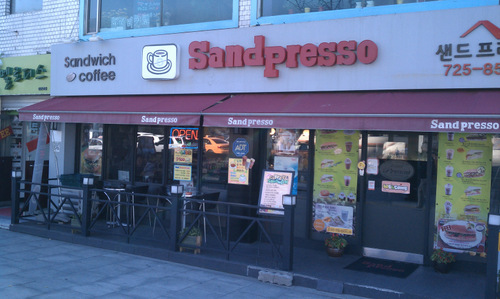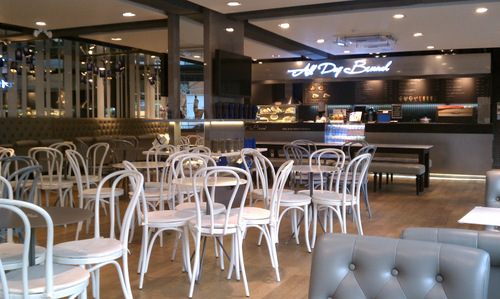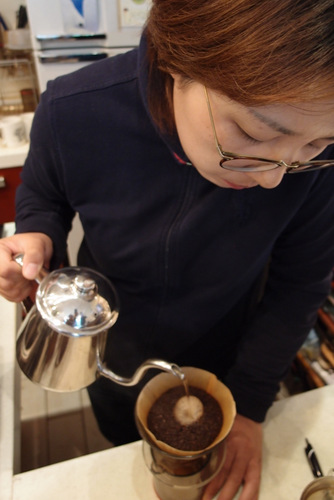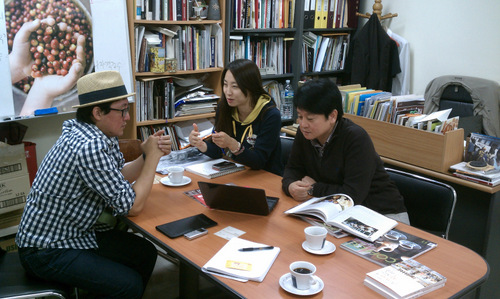Last week, I went to Seoul, South Korea, to attend a friend’s wedding and participate in a reunion of sixteen present and former Portlandians (currently living in four different countries)—Gangnam style. The trip turned out to be a fantastic cultural, social and culinary experience. In between rounds of Korean barbecue, soju (a popular Korean spirit made from rice) and even some still-squirming raw octopus (not as bad as it sounds), I spent some time checking out the city’s coffee scene.
Compared to Portland, Seoul is huge. Actually, compared to most places, Seoul is huge. The city has more than ten million residents and the entire metro area has more than twice that. In most ways, Korea is as modern as the United States, and in some ways—the efficiency of its public transportation or its communication networks, for example—more developed. Seoul’s specialty coffee scene, though not quite as cutting edge as Portland’s, is growing rapidly, with more good coffee available to Koreans than ever before.
Korea is a very welcoming country, though the language barrier can sometimes be a challenge. My own Korean is limited to hello and thank you, but fortunately, I did not have to explore Seoul’s coffee on my own. Jinsu Lee, one of the team members who worked on our Caffe PDX project, organized the coffee tours. Cory Klatik, another team member, joined us for some of the coffee expeditions as well.
Prior to the trip, I knew coffee was very popular in Korea—this summer Reuters published an article that detailed how quickly the number of cafés has grown in Seoul. Regardless, the sheer volume of cafés shocked me. In some parts of the city, each block has three or four cafés. Sometimes they are literally next door or on top of one another.
 One of Seoul's more interesting cafe iterations
One of Seoul's more interesting cafe iterations
Coffee culture is still fairly new to Korea. The Reuters article mentions the arrival of Starbucks in 1999 as the event that led Koreans to coffee. One thing not mentioned is a popular television drama from 2007 that was set in a coffee shop, called The First Café of Coffee Prince. The show won several awards and it helped make coffee cool, similar to what Friends did in America in the early 1990s. Coffee Prince gave a big lift to the Korean coffee industry.
The most prominent type of café in the city is the chain café. Starbucks, Dunkin’ and The Coffee Bean and Tea Leaf are the most prominent international chains. Coffee Bean has so many outlets that some Koreans think it is a Korean chain (it’s actually based in California). We saw several Italian franchises too—Pitti Caffe, Caffe Pascucci and Illy, to name a few.
While the internationals are popular, they no longer dominate the market like they once did. When I visited Seoul in 2009, Starbucks and Dunkin’ Donuts seemed to be everywhere. Today, you see Caffe Bene, Holly’s Coffee, Tom N Tom’s, Droptop Café, Homestead Cafe and others in just as many prominent locations. These Korean chains are usually similar to Starbucks, but with more elegant interiors and pastries. The shops make great meeting places, but generally, the coffee is average.
 Upstairs at Paris Baguette, a Korean bakery/cafe chain
Upstairs at Paris Baguette, a Korean bakery/cafe chain
Small independent roasters/cafés are also popping up. These shops do not look as corporate as the chains and often have small roasting machines sitting in the front of the cafés. After dinner the first night, we stopped at Café Arco, a small roaster in the Sinsa district, a neighborhood famous for its abundance of cafés. The espresso I had was on the sour side, but the Ethiopian “hand drip” (the Korean translation for pourover) was pretty good.
In addition to the chains and the smaller roasters, a class of independent, higher-end specialty coffee shops also exists. We visited three that were founded by past Korean barista champions. Coffee LEC (Limited Edition Café), Café I Do, and 5Extractions are three shops I highly recommend for people searching out a better cup of coffee in Seoul. Each is dedicated to improving the level of quality coffee in the city.
 Hand drip Mandheling coffee at Apgujeong Coffee School's roastery (photo courtesy Jinsu Lee)
Hand drip Mandheling coffee at Apgujeong Coffee School's roastery (photo courtesy Jinsu Lee)
You might think that all of these cafés would push each other out of the market, but there is still room for more growth. Cafés may be popular, but instant coffee still dominates the market. Mr. Sung-dae Hong, the CEO of COFFEE Magazine, told us that 70% of the coffee drunk in Korea is still instant coffee. Brands like Nescafe and Maxim sell popular mixtures of instant coffee, sugar and powdered milk that provides the drinker a warm, sweet beverage with a caffeine lift.
 Former Portland resident Jinsu Lee meeting with Jong-hee Lim, editor, and Hong Sae-dong, CEO, at COFFEE Magazine headquarters
Former Portland resident Jinsu Lee meeting with Jong-hee Lim, editor, and Hong Sae-dong, CEO, at COFFEE Magazine headquarters
Compared to Portland, one thing that is different about Seoul’s coffee shops is that they stay open much later than those in Portland. Coffee is less a morning drink than an afternoon or evening drink. Most cafés we visited stayed open until at least 11pm, with many open until midnight or later. Unlike in Portland, you do not see many people sitting alone in cafés. In Portland, cafés are a often place to go when “you want to be alone with other people.”** In Seoul, I did not see many people sitting at a table, coffee in hand, staring blankly into the depths of their laptop.
My overall impression of Seoul’s café scene is that there are lots of large cafés with beautiful interiors and decent coffee. Considering how new the coffee culture is though, Korea has done great things, with more to come. Coffee purists might not be ready to give Seoul top marks for its coffee, but at its current rate of improvement, Seoul should be one of the best coffee cities in the world by the end of the decade.
* After living in Portland the last eight years, Jinsu moved back to Korea last week. It’s hard to believe he won’t be around Portland anymore to study coffee with me, but we had a great farewell tour of Seoul and his hometown of Gwacheon, just south of Seoul (more on Gwacheon later). Searching out a new set of cafés ought to keep him busy for a while.
** not my words, but I can’t find the original citation